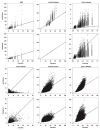Variations in predicted risks in personal genome testing for common complex diseases
- PMID: 23807614
- PMCID: PMC3883880
- DOI: 10.1038/gim.2013.80
Variations in predicted risks in personal genome testing for common complex diseases
Abstract
Purpose: The promise of personalized genomics for common complex diseases depends, in part, on the ability to predict genetic risks on the basis of single nucleotide polymorphisms. We examined and compared the methods of three companies (23andMe, deCODEme, and Navigenics) that have offered direct-to-consumer personal genome testing.
Methods: We simulated genotype data for 100,000 individuals on the basis of published genotype frequencies and predicted disease risks using the methods of the companies. Predictive ability for six diseases was assessed by the AUC.
Results: AUC values differed among the diseases and among the companies. The highest values of the AUC were observed for age-related macular degeneration, celiac disease, and Crohn disease. The largest difference among the companies was found for celiac disease: the AUC was 0.73 for 23andMe and 0.82 for deCODEme. Predicted risks differed substantially among the companies as a result of differences in the sets of single nucleotide polymorphisms selected and the average population risks selected by the companies, and in the formulas used for the calculation of risks.
Conclusion: Future efforts to design predictive models for the genomics of common complex diseases may benefit from understanding the strengths and limitations of the predictive algorithms designed by these early companies.
Conflict of interest statement
The authors declare no conflict of interest.
Figures

Similar articles
-
Direct-to-consumer personal genome testing for age-related macular degeneration.Invest Ophthalmol Vis Sci. 2014 Aug 21;55(10):6167-74. doi: 10.1167/iovs.14-15142. Invest Ophthalmol Vis Sci. 2014. PMID: 25146986
-
Systematic evaluation of personal genome services for Japanese individuals.J Hum Genet. 2013 Nov;58(11):734-41. doi: 10.1038/jhg.2013.96. Epub 2013 Sep 26. J Hum Genet. 2013. PMID: 24067293
-
Genomic Prediction of 16 Complex Disease Risks Including Heart Attack, Diabetes, Breast and Prostate Cancer.Sci Rep. 2019 Oct 25;9(1):15286. doi: 10.1038/s41598-019-51258-x. Sci Rep. 2019. PMID: 31653892 Free PMC article.
-
The regulation of direct-to-consumer genetic tests.Hum Mol Genet. 2008 Oct 15;17(R2):R180-3. doi: 10.1093/hmg/ddn253. Hum Mol Genet. 2008. PMID: 18852208 Free PMC article. Review.
-
New advances in the genetic basis of atrial fibrillation.J Cardiovasc Electrophysiol. 2012 Dec;23(12):1400-6. doi: 10.1111/j.1540-8167.2012.02445.x. Epub 2012 Oct 15. J Cardiovasc Electrophysiol. 2012. PMID: 23066792 Free PMC article. Review.
Cited by
-
Genetic risk models: Influence of model size on risk estimates and precision.Genet Epidemiol. 2017 May;41(4):282-296. doi: 10.1002/gepi.22035. Epub 2017 Feb 15. Genet Epidemiol. 2017. PMID: 28198095 Free PMC article.
-
Crowdsourced direct-to-consumer genomic analysis of a family quartet.BMC Genomics. 2015 Nov 7;16:910. doi: 10.1186/s12864-015-1973-7. BMC Genomics. 2015. PMID: 26547235 Free PMC article.
-
Estimation of the risk of a qualitative phenotype: dependence on population risk.J Hum Genet. 2017 Feb;62(2):191-198. doi: 10.1038/jhg.2016.106. Epub 2016 Aug 25. J Hum Genet. 2017. PMID: 27557667
-
Public reactions to direct-to-consumer genetic health tests: A comparison across the US, UK, Japan and Australia.Eur J Hum Genet. 2020 Mar;28(3):339-348. doi: 10.1038/s41431-019-0529-8. Epub 2019 Oct 23. Eur J Hum Genet. 2020. PMID: 31645768 Free PMC article.
-
Summarizing polygenic risks for complex diseases in a clinical whole-genome report.Genet Med. 2015 Jul;17(7):536-44. doi: 10.1038/gim.2014.143. Epub 2014 Oct 23. Genet Med. 2015. PMID: 25341114 Free PMC article.
References
-
- 23andMe. [Accessed 1 January 2012 and 1 December 2012]; https://www.23andme.com/
-
- deCODEme. [Accessed 1 January 2012 and 1 December 2012]; http://www.decodeme.com/
-
- Navigenics. [Accessed 1 January 2012 and 1 December 2012]; http://www.navigenics.com/
-
- Janssens AC, van Duijn CM. Genome-based prediction of common diseases: advances and prospects. Hum Mol Genet. 2008;17(R2):R166–R173. - PubMed
Publication types
MeSH terms
Grants and funding
LinkOut - more resources
Full Text Sources
Other Literature Sources
Medical

